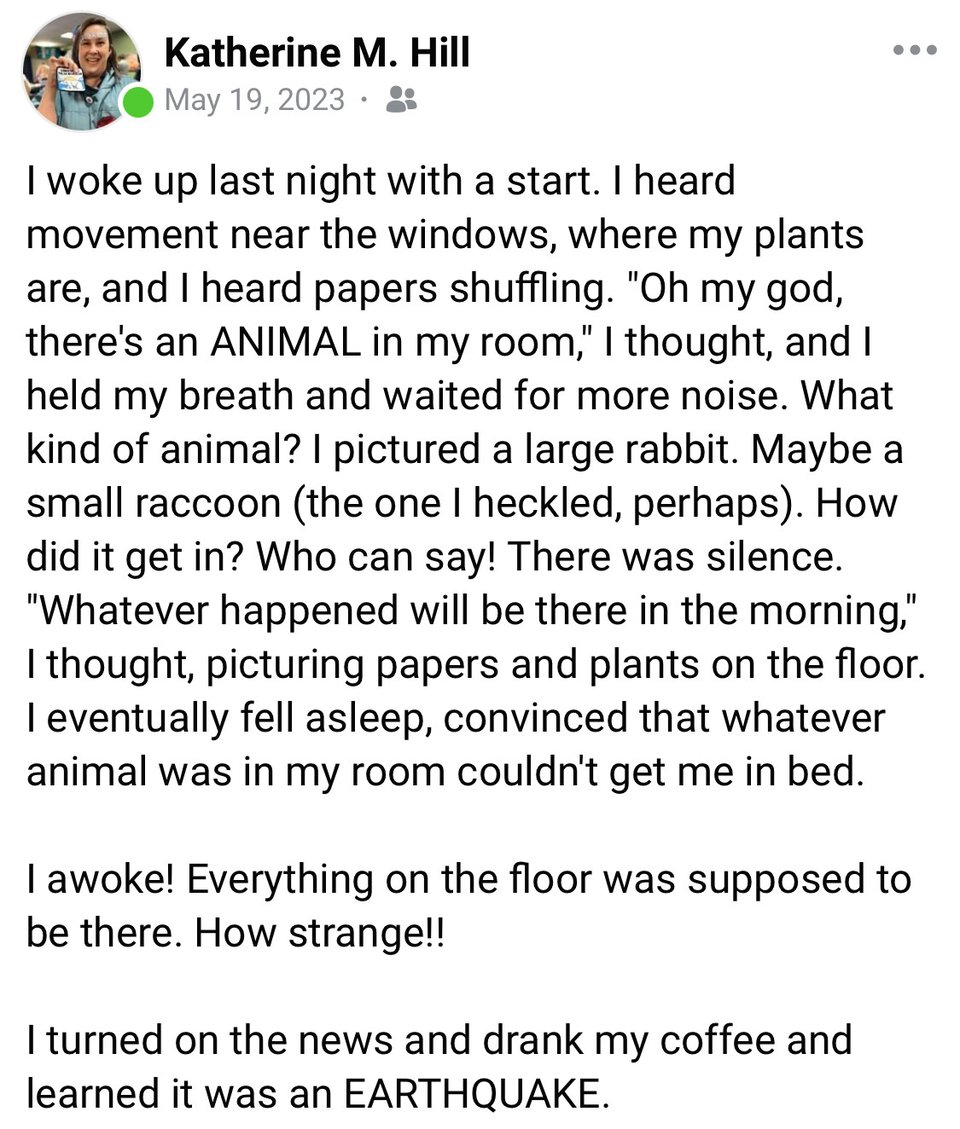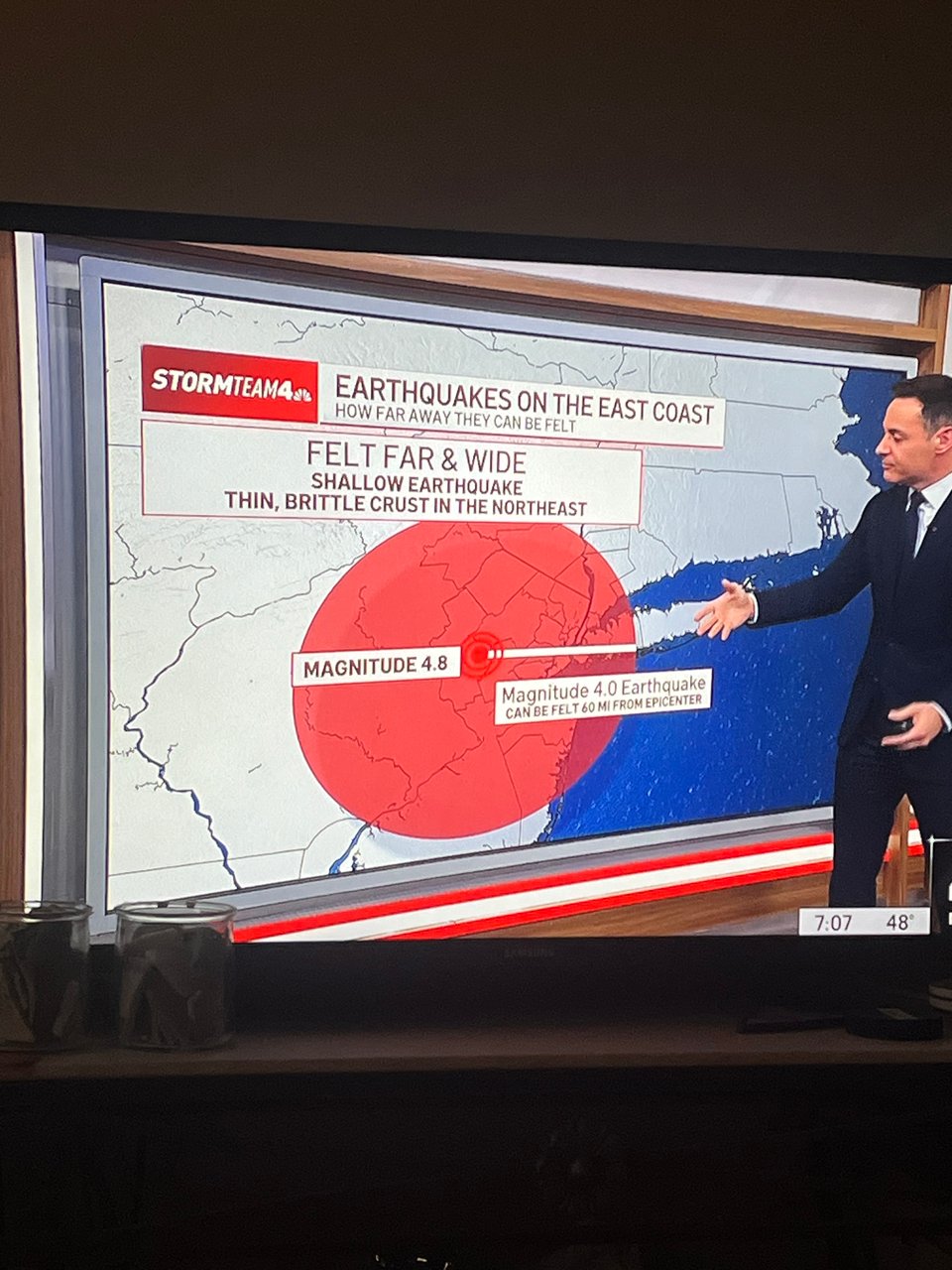The Ramapo Fault

Hi Bestie!!
Are you sick of earthquake content? Too bad!!
We had an earthquake in New York City last Friday. I was in bed and sat up to watch my plants shimmy in the window. I had a phone call and stayed inside (a good thing, since it was a while before I got the notice not to leave) and we had an aftershock in the early evening. I waited for subsequent aftershocks while writing, because they can continue for up to three days.

Because the tri-state has "brittle, shallow rock" (Matt Brickman, NBC4) the reverberations can travel quite far. Reverberations in Philadelphia don't seem odd to me, because the 2011 Virginia earthquake made its way to my lower Manhattan office (and beyond – as far south as Florida and as far north as Canada). I remember that earthquake as inconsequential (except for damaging the Washington Monument) but Wikipedia (a true journalist) reported that people evacuated their buildings and flights were delayed.
The people working in my building evacuated, too! (A good idea because I think it's a gut reno downstairs.) That's generally not the guidance, unless you know it's unsafe (and I guess they did, there is no shame to the perfectly nice people working for my landlord). If you're in bed, stay in bed (lay face down and protect ya neck unless you're under a "heavy light fixture." If you're inside, stay inside and take shelter under a sturdy table. If you're outside, stay outside. "Ground movement during an earthquake is seldom the direct cause of death or injury." That's usually caused by falling objects, inside or outside.
New York City is not on a faultline, but New Jersey is. Though all states can have earthquakes (thanks, Big Bird) I've only experienced them in Brooklyn and Manhattan. Let's bust out some Cool Facts About Earthquakes:
Antarctica has the least earthquakes of any continent; it has icequakes, which are more frequent than earthquakes.
North Dakota and Florida have the least recorded earthquakes in the U.S. Alaska and California have the most.
The San Andreas Fault, named for the valley (not the lake) runs the length of California and is a series of faults, not one long one. The same is true for Ramapo which stretches from New York through New Jersey to Pennsylvania.
The largest earthquake in the U.S. was in Alaska in 1964 at a magnitude of 9.2. (The largest in the world was in Chile at a magnitude of 9.5 in 1960!) See Portage, Alaska and Earthquake Park; the Good Friday earthquake led to the understanding of plate tectonics!
The hypocenter is where the rupture in the earth is located. The epicenter is the aboveground location above the hypocenter.
There are 500,000 detectable earthquakes a year. 100,000 can be felt and 100 cause damage.
The fire following the 1960 San Francisco earthquake probably caused more damage than the earthquake itself. (I'll be reading more about that.)
The word for the sloshing of water inside a swimming pool in an earthquake is seiche. "...It is the sloshing of the water in your swimming pool, or any body of water, caused by the ground shaking in an earthquake. It may continue for a few moments or hours, long after the generating force is gone. A seiche can also be caused by wind or tides."
There is no such thing as earthquake weather. Cold, warm, humid, rainy, muggy, it's all the same distribution.
I need to say again that there are lots and lots of earthquakes that we don't know about because we don't feel them and presently none of us are seismologists. There is always an earthquake somewhere.
Earthquakes build mountains, including this young range in Montana:

Do you think I'm going to find out one day that the advice for quicksand is incorrect? Has anyone told the mayor his advice was incorrect? Don't stand in a doorway!
Let's talk about the Ramapo Fault, though, since it's "part of the geologically complex structure of the Northern Appalachian Mountains." We had a continental collision and the formation of the mountain range, followed by the fault. (And it all goes back to Pangea, which is true, and not a joke, this one time.)

In California, scientists can study the San Andreas Fault and make predictions but that is not the case here: "The NYC area is far from the boundaries of the North American plate, which are in the center of the Atlantic Ocean, in the Caribbean Sea, and along the west coast of North America. The seismicity of the northeastern U.S. is generally considered to be due to ancient zones of weakness that are being reactivated in the present-day stress field." New York City: always special. Also special: there are probably a bunch of faults in the Northeast we don't even know about.
Breathe! I think it's great that we have so much to learn about our world and ourselves. It makes life worth living. (So, too, are the fart jokes you tell me.) It turns out that earthquakes in the eastern half of the country travel much further than earthquakes in California, Oregon, and Washington.
Earthquakes in the area are often attributed to the Ramapo Fault but there is little evidence. The earthquake in 1884 was thought to be caused by the fault but that was determined to be false because the epicenter was in Brooklyn. The fault runs through the boroughs but it does not run through Brooklyn. If anything, the fault is a problem for New Jersey, which is the most densely populated state in the country. Because the earthquake was in New Jersey and shallow, it is currently attributed to the Ramapo Fault.
When I moved to New York there was a lot of concern for the Indian Point Nuclear Power Plant. It sits near the northern end of the fault. The early 2010s were a peaceful time, weren't they? We had so many what-ifs to worry about. The plant is closed now and being decommissioned. The Limerick Nuclear Power Plant in Pottstown, PA is at the other end. I grew up in Maryland; I try not to think too hard about Pennsylvania's nuclear power.
A much cooler phenomenon than nuclear disaster is the existence of ghost forests, "watery remains of a once verdant woodland." Earthquakes cause ghost forests, usually in two ways. Subsequent tidal activity brings salt water to the roots of trees, causing the trees to die but remain where they are. An example of this is in Portage, where the trees still stand.
Another cause is the movement of the trees into salt water. Earthquakes can change the shape of the coastline. Ghost forests in Oregon were formed when the earthquake moved the forest into the path of the ocean. The Neskowin Ghost Forest, made of Sitka spruce stumps is on the Neskowin Beach and can be seen at low tide. (People recommend visiting the beach in the winter for the best chance to see it. You can also climb onto Proposal Rock during low tide, so yes, I bookmarked it.) The stumps are 2,000 years old and have been preserved by salt water.
Lake Washington has a sunken forest. The existence of the old-growth timber in the lake was known to colonizers in the early 20th century. (Trees in a body of water are at best, a hindrance, and at worst, a widow maker.) In the 1990s, Western Wood Lumber was salvaging the wood at a profit, and the Washington State Supreme Court decided they couldn't – the "bizarre submerged forests" belong to the state of Washington. Along the way, the Seattle Fault was discovered in 1992!
Rye, New Hampshire has a submerged forest, too! Scuba divers explore and study the 4,000-year-old trees near Odiorne Point State Park. Occasionally you can see a sunken forest during low tide at Jenness Beach. Those trees are 3,400 years old.
And the transatlantic telegraph cable ran through the roots of the trees in Rye to Ireland. The cable was laid in 1874. Photographs of the cable running through the forest at low tide were published in a local paper in 1958.
Ghost forests are also caused by rising tides and eroding coastline, as is the case in the Carolinas.
I woke up Saturday morning and wondered if there had been a bored, sweet teenager who had wished for "something, anything to happen" and received the earthquake in return.
Dribs and Drabs
Respectfully, I don't think a single one of you has told me a fart joke. You're mature. That responsibility rests on me, but the point stands.
I had no idea New Jersey was the most densely populated state. Let's talk about three of its tiny towns, though. Walpack has an estimated population of eight and has the smallest population in the state. The Army Corps of Engineers proposed building a dam in the 1950s and claimed eminent domain – but the dam wasn't built. People moved and the town remains. It looks like there's plenty of hiking (including Buttermilk Falls) to do in the area and people online recommend the Walpack Inn. I nosed around on Google Maps and it's like Centralia without the fire.
Tavistock has nine people in its town. It was formed so members of the Tavistock Country Club could golf on Sundays. In 1930 its population was 20. It peaked in 1990 with 35 people. The property tax bill in Tavistock is $31,376 – the average in New Jersey is around $8,767.
Similarly, Pine Valley has a population of 21 and is encompassed by the Pine Valley Golf Club. However, it was merged with Pine Hill in 2022, just like a plotline in Parks & Recreation.
I can't imagine liking golf enough to live on a golf course. I could never live like Ree Drummond.
Always your friend,
Katherine
Sources (MLA 9)
“2011 Virginia Earthquake.” Wikipedia, Wikimedia Foundation, 2 Jan. 2024, en.wikipedia.org/wiki/2011_Virginia_earthquake.
Adams, Mayor Eric. “In Case of Aftershocks: Get down on the Floor, Cover Your Head and Neck, and Take Additional Cover under a Solid Piece of Furniture, next to an Interior Wall, or in a Doorway.” Twitter, Twitter, 5 Apr. 2024, twitter.com/NYCMayor/status/1776275247450165428.
“Cool Earthquake Facts.” Cool Earthquake Facts | U.S. Geological Survey, www.usgs.gov/programs/earthquake-hazards/cool-earthquake-facts. Accessed 9 Apr. 2024.
“Earthquake of 1884 in New York: The William Steinway Diary: 1861-1896, Smithsonian Institution.” Smithsonian Institution National Museum of American History: Kenneth E. Behring Center, americanhistory.si.edu/steinwaydiary/annotations/?id=951. Accessed 9 Apr. 2024.
“Earthquake Park.” Atlas Obscura, Atlas Obscura, 16 Aug. 2023, www.atlasobscura.com/places/earthquake-park-anchorage-alaska.
“Effects of Hurricane Isabel in Maryland and Washington, D.C.” Wikipedia, Wikimedia Foundation, 19 Sept. 2023, en.wikipedia.org/wiki/Effects_of_Hurricane_Isabel_in_Maryland_and_Washington,_D.C.
Hill, Katherine. “The Frontier Was Always Stolen.” Too Loud And Too Old, 1 Oct. 2023, buttondown.email/KatherineMHill/archive/the-frontier-was-always-stolen/.
How Often Do Earthquakes Occur?, www.mgs.md.gov/seismic/education/no3.pdf. Accessed 10 Apr. 2024.
“Portage Ghost Town.” Atlas Obscura, Atlas Obscura, 3 Dec. 2018, www.atlasobscura.com/places/portage-ghost-town.
Prater, Nia. “New York’s Earthquake Response Was Very Shaky.” Intelligencer, Intelligencer, 5 Apr. 2024, nymag.com/intelligencer/article/new-york-eric-adams-earthquake-response.html.
“Ramapo Fault.” Wikipedia, Wikimedia Foundation, 8 Apr. 2024, en.wikipedia.org/wiki/Ramapo_Fault.
“Seismicity of the New York City Area.” Wikipedia, Wikimedia Foundation, 8 Apr. 2024, en.wikipedia.org/wiki/Seismicity_of_the_New_York_City_area.
“Stay Safe during an Earthquake.” Centers for Disease Control and Prevention, Centers for Disease Control and Prevention, 24 Sept. 2020, www.cdc.gov/disasters/earthquakes/during.html#:~:text=Move%20away%20from%20buildings%2C%20utility,there%20until%20the%20shaking%20stops.
“Stay Safe during an Earthquake.” Centers for Disease Control and Prevention, Centers for Disease Control and Prevention, 24 Sept. 2020, www.cdc.gov/disasters/earthquakes/during.html#:~:text=Move%20away%20from%20buildings%2C%20utility,there%20until%20the%20shaking%20stops.
“Three Mile Island Accident.” Wikipedia, Wikimedia Foundation, 6 Apr. 2024, en.wikipedia.org/wiki/Three_Mile_Island_accident.
US Department of Commerce, National Oceanic and Atmospheric Administration. “What Is a Ghost Forest?” NOAA’s National Ocean Service, 26 Oct. 2017, oceanservice.noaa.gov/facts/ghost-forest.html.
“What to Do during an Earthquake.” What to Do during an Earthquake | Maine Emergency Management Agency, www.maine.gov/mema/hazards/natural-hazards/earthquake/during#:~:text=Stay%20away%20from%20glass%2C%20windows,light%20fixture%20that%20could%20fall. Accessed 9 Apr. 2024.
Wiki, Contributors to Muppet. “Beatin’ the Quake.” Muppet Wiki, Fandom, Inc., muppet.fandom.com/wiki/Beatin%27_the_Quake. Accessed 9 Apr. 2024.
Wiki, Contributors to Muppet. “Big Bird Get Ready.” Muppet Wiki, Fandom, Inc., muppet.fandom.com/wiki/Big_Bird_Get_Ready#For_Earthquakes_(1989). Accessed 9 Apr. 2024.
“Wu-Tang Clan - Protect Ya Neck (Official HD Video).” YouTube, YouTube, 10 Mar. 2013, www.youtube.com/watch?v=R0IUR4gkPIE.
